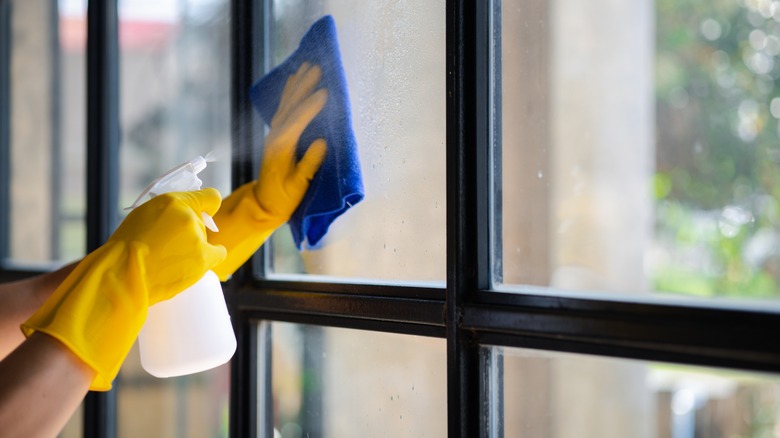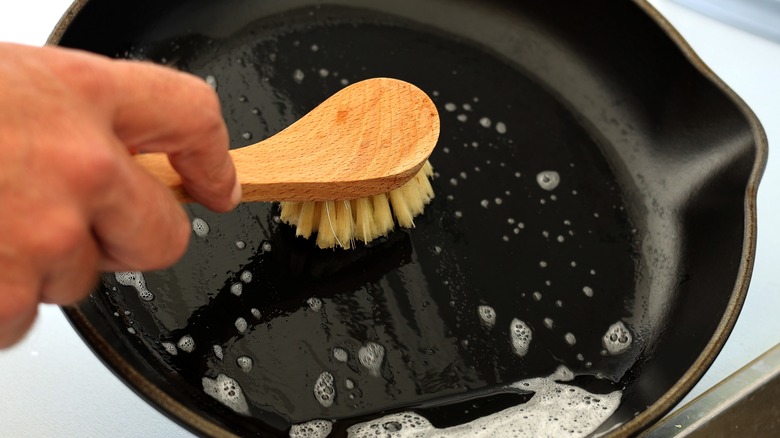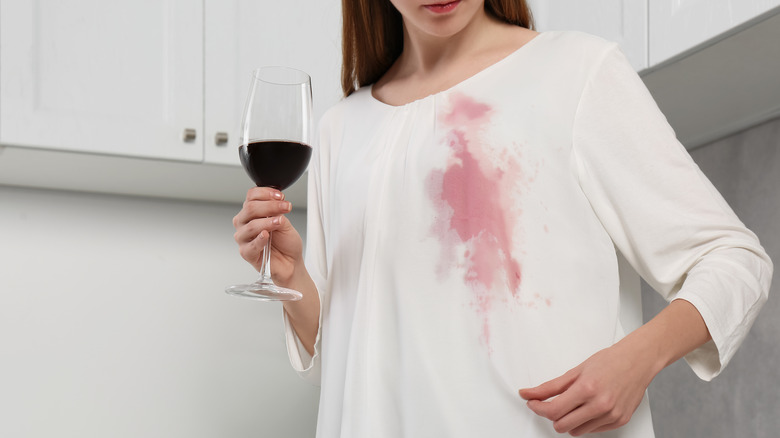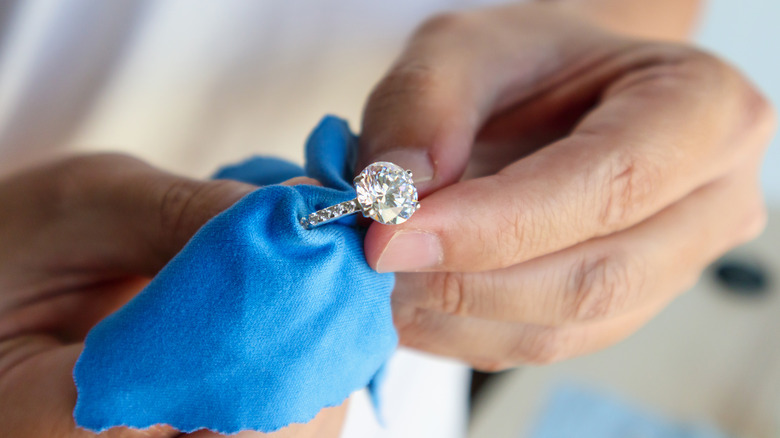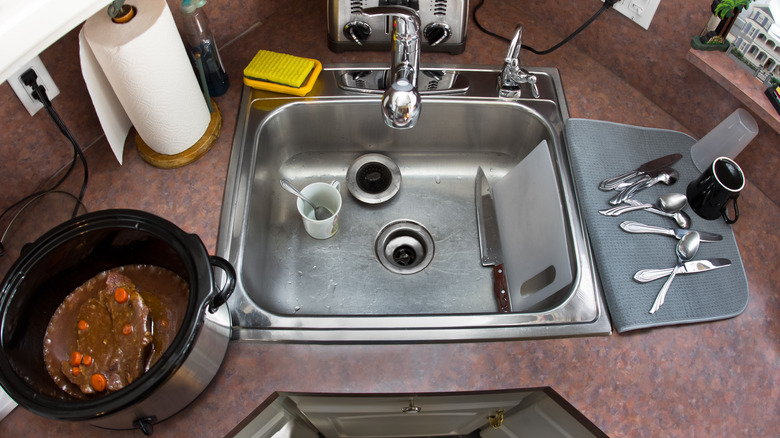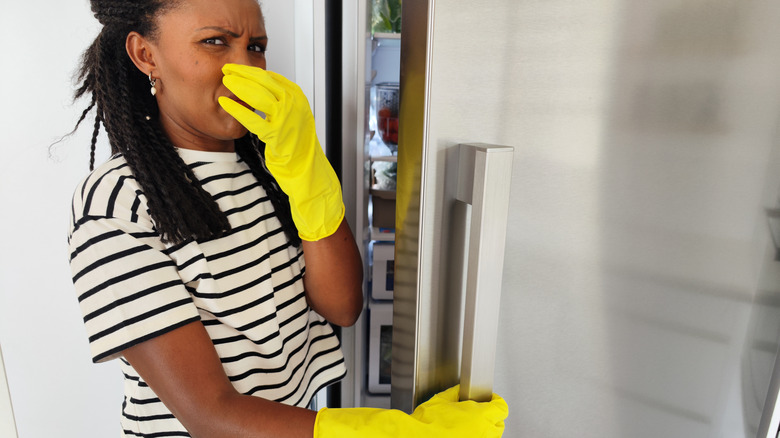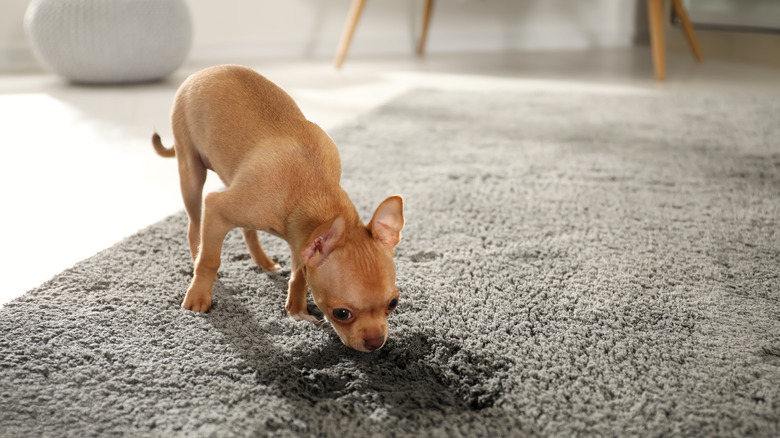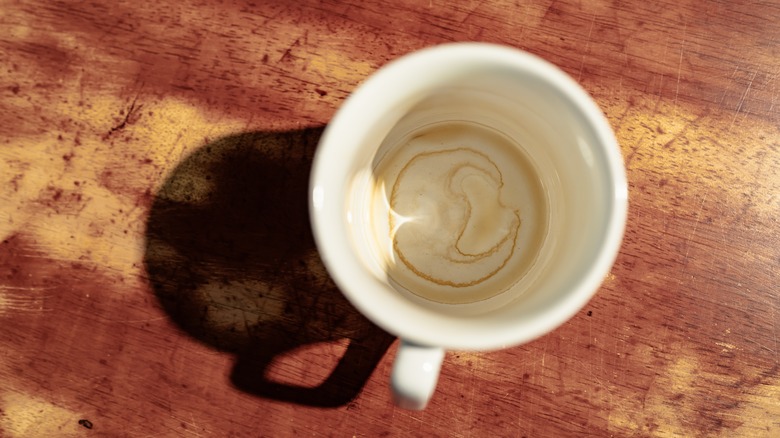All The Unexpected Ways You Should Be Using Club Soda Around The House
It's easy to get caught up in the hype around trendy cleaning products like TikTok's favorite cleaner — The Pink Stuff. In many cases, the awe surrounding these products may even be justified. However, it is also true that nearly every cleaning conundrum can be tackled with a more natural (and less expensive) household staple. Some of those staples can be put to work around your home in more ways than others. One of the most versatile of these multiuse pantry items is humble club soda. Yes, the same kind you keep on your bar for emergency gin rickeys.
Club soda is simply carbonated mineral water wherein the minerals are added rather than naturally occurring. Traditionally, this allows you to add a crisp, refreshing bubbliness to any drink without adding strong flavors or sweetener. Those stain-lifting bubbles and slightly acidic minerality also create the perfect storm for household uses like cleaning, cooking, and gardening. From greener houseplants to shinier kitchen appliances, you'll be shocked by all the tasks a 67 cent can of club soda can help you accomplish around your home.
Clean your mirrors and windows
If you've ever used diluted white vinegar to make your own homemade window cleaner, you're familiar with the concept that a mildly acidic solution can lift away smudges from glass surfaces. Simply replace the acetic acid in white vinegar with the carbonic acid in club soda, and you've got an equally effective glass cleaner — without the intense scent of salad dressing. While club soda is less acidic than vinegar, its carbonated bubbles make up the difference by doing their own part in lifting away the grime.
There is no mixing or diluting necessary when cleaning with club soda; it is water, after all. To use it for cleaning glass like windows or mirrors, simply pour some into an empty spray bottle. Apply it directly to glass as you would any other commercial or homemade glass cleaner. Wipe until clean and dry with a squeegee or a lint-free cloth and stand back to admire your squeaky clean glass.
Remove rust from cast iron pans
One of the most notoriously difficult to maintain items in most kitchens is the classic, timeless cast iron skillet. If not cleaned and dried properly (and promptly) after use, cast iron pans can quickly become rusty. After all, rust occurs when water — which is present in most foods — mixes with iron. If you've inadvertently neglected to care for your cast iron pan to the point that it developed rust, don't worry. The carbonic acid in club soda can reverse this oxidation process.
If you notice that your cast iron pan is starting to look tarnished or rusty, keep some club soda on hand for the next time you cook in it. After you've finished cooking and removed any remaining food from the pan, pour your club soda in while the pan it is still hot. Let the pan soak for a few hours — or even overnight — and then give it a gentle scrub to easily remove both the rust and any remaining stuck-on food that the soda has lifted away.
Perk up your house plants
Watering your houseplants isn't a chore you can skip if you want them to survive and continue to breathe joy and vibrancy (and oxygen) into your home. Because you'll be taking the time to water your plants anyway, consider setting aside your leftover club soda the next time it goes flat. When watering day arrives, swap your usual tap water with the flat club soda for extra nourished and vibrant houseplants.
Some of the minerals that are added to club soda to give it its crisp taste and bubbles happen to be the same ones that are essential to plant growth. Oxygen, hydrogen, phosphorus, sulfur, sodium, and potassium are all key ingredients for successful plants and delicious club soda. Because plants can be overloaded with too many nutrients, it's best to limit yourself to treating them to club soda once every few waterings — or only when they're looking like they could use a boost.
Remove laundry stains
If there is a household use that club soda is already well known for, it's removing clothing stains. So many scenes in films and television shows show someone applying club soda to red wine stains on fancy cocktail dresses that you might have wondered whether this trick is just a myth. Fortunately, removing certain stains with club soda really is possible. Club soda is acidic in nature thanks to its carbonic acid content. Applying an acidic solution to an alkaline stain — like red wine, tea, coffee, or mustard — can neutralize it.
Combined with the lifting power of club soda's many bubbles, this makes it the most useful stain remover you'll find on any bar. Simply pour the soda directly onto the stain as soon as possible after the spill occurs. Continue to flush the stain away with the club soda until it disappears or significantly lightens. You can also let the club soda soak into the stain for a few hours, if necessary. Then, be sure to promptly launder the garment.
Clean your jewelry
The household magic that club soda has to offer isn't limited to laundry stains and rusty pans. You can also put it to work on dirty or tarnished jewelry. If you've attempted to clean your favorite pieces of jewelry with homemade solutions before, you may have found out the hard way that highly acidic substances like vinegar and lemon juice can damage both precious metals and gemstones. Club soda, however, is only slightly acidic — meaning it's gentle enough for your most treasured jewelry pieces.
The same combination of slight acidity and carbonated bubbles that gives club soda the power to lift away rust and fabric stains allows it to gently remove dirt, oils, and mild tarnish from jewelry. If your frequently worn ring or necklace starts to look dingy between professional cleanings, soak them in club soda overnight and dry them thoroughly with a microfiber cloth in the morning for a brand new sparkle.
Unclog a slow drain
Suffering from slow drains? There's a reason plumbers warn to avoid Drano: treating a clogged drain with commercial drain cleaners containing caustic chemicals can damage pipes and septic systems. If you're looking for a gentler solution, try reaching for a can or bottle of club soda. While accounts of club soda successfully cleaning drains seem to be anecdotal for the most part, that doesn't necessarily mean it isn't worth a shot, especially when the alternatives can be harsh on your plumbing.
Most of the online sources that recommend using club soda to unclog a drain call for mixing a couple of cups of the soda with a couple of tablespoons of table salt. The idea seems to be that the acidity of the club soda combined with the power of its carbonation and the abrasive nature of the salt will help to dissolve the clog enough for it to slide through your pipes without further obstruction.
Refresh your fridge
Because refrigerators exist to store an entire household's supply of perishable food, it isn't surprising that they often also store a plethora of unpleasant stains and odors. Fortunately, club soda can likely come to the rescue for your fridge in more ways than one. If you're looking to clean up spills and stuck-on messes or prevent odors from lingering, club soda could be the natural, inexpensive solution you seek thanks to its gentle acidity, minerality, and carbonation.
While there doesn't appear to be much scientific research dedicated to the role of club soda in refrigerator maintenance, plenty of cleaning blogs and forums around the internet swear by its effectiveness. They frequently recommend using club soda to wipe away spills and food residue. Leaving a small open container of club soda in your fridge to absorb lingering odors is also a common recommendation. Considering how inexpensive and accessible the drink is, it's probably worth a try. Just keep in mind that club soda alone isn't a disinfectant cleaner, as WebMD notes.
Remove pet urine stains
Of all household cleaning challenges, stains from pet accidents can be the most frustrating and embarrassing to deal with. For those who are going through the difficulties of house training, litter training, or pet incontinence, club soda can help with urine stains. Because urine stains are alkaline in nature, applying an acidic solution like club soda can neutralize them in the same way it neutralizes a red wine or coffee stain.
When a pet urine accident strikes, soak up as much excess urine as possible with an absorbent towel or cloth. Then, pour a generous amount of club soda directly onto the stain and scrub it with the bubbling liquid. When the area has air-dried, cover it with a layer of baking soda for a few hours to absorb any remaining liquid along with any remnants of urine's trademark ammonia odor. Then, vacuum up the baking soda. If any odor remains after the process is complete, move on to an enzyme-based cleaner that can bind to and remove stubborn uric acid crystals.
Shine your stainless steel appliances
In today's world, stainless steel appliances feel almost like a requirement for a modern kitchen. While these shiny appliances can kick your kitchen's aesthetic up a notch, they can also be on the challenging side to keep clean. If you're new to stainless steel appliances, you'll soon notice that they tend to showcase every smudge and fingerprint they encounter. It's probably no surprise by now to hear that club soda can combat these marks and leave your appliances shining thanks to its acidity and carbonation.
If you're looking for a natural cleaning solution for your smudged stainless steel appliances, give a can of club soda a try. All you need is to apply some club soda to a soft microfiber cloth and use it to scrub away the smudge. Scrub in small circular motions, following the grain of the steel. Repeat for each smudge or scrub the entire surface. Because you're cleaning with water, there's no need to rinse or dry.
Restore stained porcelain mugs
Club soda's ability to neutralize alkaline stains doesn't only apply to fabric. If your favorite coffee mug is looking a little brown on the inside — no matter how many times you wash it — it may be time to give the stain-fighting properties of club soda a try. As per usual, the soda's carbonic acid, minerals, and scrubby bubbles are responsible for its ability to stop coffee and tea stains in their tracks and lift them away.
To give the inside of your mug a bright new lease on life, simply fill it with club soda and let it sit overnight. The next morning, empty the mug and gently scrub away the stains. Because club soda is such a gentle cleaning solution and lacks harsh chemicals, there is no harm in repeating this process anytime you start to see stains beginning to form in the mug again in the future — or in simply adding it to your weekly cleaning routine. If removing the coffee stains reveals too many scratches, it may be time to repurpose your mug around the house.


